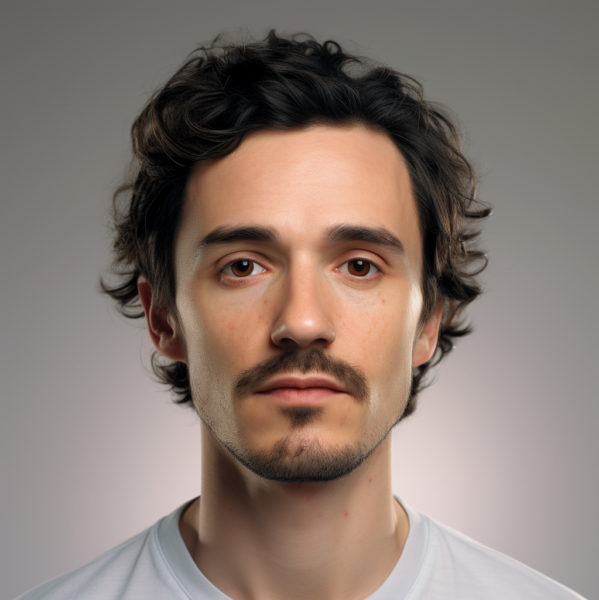Introduction: The beard’s unique characteristics, closely tied to ethnicity, have made it a subject of significant interest in hair studies. Its extent and thickness vary widely, and for certain ethnicities, it may be almost non-existent. During early childhood, the soft and fine vellus hair found on the chin, cheeks, upper lip, and neck’s front part mirrors that found on other body parts, showing no distinguishable differences between boys and girls. However, an obvious disparity in visible facial hair exists between men and women in most ethnic groups. Whereas facial hair is virtually absent in women (in the absence of hormonal disruption), it emerges in men during puberty, a process fuelled by the signalling of male hormones, known as androgens, to androgen receptors on hair follicle dermal papilla cells
First Onset of Beard Hair Development: Beard hair begins to make its appearance in boys during puberty under the influence of male hormones. It is usually first noticed between the ages of 13-16, but there are exceptions with some boys observing growth as early as 9 or as late as 19 years of age. Approximately half of boys in the USA are shaving at 16. The majority have a shavable beard by 17 years of age. This variability between boys seems partly genetic, with timing of first beard growth onset appearing to run in families. However, historical texts do suggest that beard development may be occurring earlier in the general population. Documents from ancient Greece and Rome, through medieval times in Northern Europe, and into the early 19th Century, suggest that beard development did not occur in youths until they were around 20 years of age. Even in the early 20th Century, research studies indicate first beard growth was typical at 18-19 years of age. That beard development now seems to commonly occur during mid teenage years suggests that better nutrition (see below) in the modern age allows for younger onset of puberty and consequently, earlier onset of beard growth.
Stages of Beard Hair Growth:
Upper Lip Growth : Almost invariably, the upper lip is the first site of beard development. The lateral corners of the upper lip begin to sprout terminal hair at puberty. This initial hair growth then fills in across the full lip. This moustache formation is slow and gradual and can take several months to 2 years to reach full density. The initial rate of terminal hair growth is also relatively slow and speeds up over a similar time frame. Hair in adult beards grows at a somewhat faster rate than scalp hair.Chin and Sideburn Growth : Following moustache formation, short and often curly terminal hairs emerge on the chin. At this stage, the young man might begin shaving. Due to the initially slow rate of hair growth, it may not be necessary to shave every day until several years after the initial beard growth begins. Gradually, beard hair enlarges and appears in new areas, thickening around the chin and extending towards the ears, forming sideburns.Full Development : The beard hair invasion proceeds further, ultimately covering the cheeks and extending downward over the neck. For a full beard, the upper boundary of the pigmented terminal beard hair on the face is generally represented by a line drawn from the nostril across the cheekbone to the ear’s highest attachment point. A zone approximately 1 cm wide directly in front of the ear typically lacks terminal hair.Factors Affecting Beard Hair Growth : Apart from genetic factors, other elements influence beard hair development. These can include:
Hormonal Factors : Testosterone and other androgens play a crucial role in triggering facial hair growth. For some people a genetic condition may significantly reduce testosterone production, or might alter the androgen receptor gene such that androgen receptors on cells are non-functional, though such a condition is very rare. Men who may be castrated pre-puberty also typically do not grow beards, though with testosterone supplements beard growth can develop.Ethnicity : As previously mentioned, certain ethnic/gene backgrounds can exhibit differences in beard growth. While there are always individual exceptions, men of European and Middle Eastern descent are more likely to develop full beard growth. For men of Far East Asian descent, beard hair growth tends to be more limited and may only be visible on the moustache and chin area. For men of American Indian and Polynesian descent beard growth may also be limited, though it should be noted that the degree of beard growth can be much greater for men of some specific tribes. For example, Chumash and Navajo men can have much fuller beard hair growth.Health and Nutrition : Proper nourishment and overall well-being may also contribute to the development and maintenance of beard hair. Boys growing up in regions of the world with limited access to good nutrition may see a delay of several years in the first onset and progression of their beard growth. Studies suggest that even with good nutrition it can take until the age of around 30 before the maximal degree of beard growth is achieved. Once the beard has developed, subsequent poor nutrition has only a limited effect, but at least one study suggests a slowdown in beard hair growth can occur as a result of poor nutrition.Conclusion: Beard hair development is a complex phenomenon encompassing various stages and influenced by genetics, hormones, ethnicity, and other factors. Its understanding provides insights not just into the bodily changes occurring during puberty in males, but also into broader biological, anthropological, and sociocultural contexts. Continued exploration in this area may lead to further insights into hair and skin diseases, an avenue that presents promising implications for clinical practice and human health.
Bibliography
11711645 {11711645:W2V2SVF2},{11711645:5895ZS2Z},{11711645:6SIVV6NH},{11711645:KBB6D2GN},{11711645:NUWWVQ74},{11711645:I2GNC5SH},{11711645:78NVD7QE},{11711645:S7ZRE5M4},{11711645:ZVH8U94P},{11711645:PRP6BVSF} vancouver 50 date asc 505 https://www.keratin.com/wp-content/plugins/zotpress/ %7B%22status%22%3A%22success%22%2C%22updateneeded%22%3Afalse%2C%22instance%22%3A%22zotpress-40b4f60c3b699873048f3d9af9cf4373%22%2C%22meta%22%3A%7B%22request_last%22%3A0%2C%22request_next%22%3A0%2C%22used_cache%22%3Atrue%7D%2C%22data%22%3A%5B%7B%22key%22%3A%22I2GNC5SH%22%2C%22library%22%3A%7B%22id%22%3A11711645%7D%2C%22meta%22%3A%7B%22creatorSummary%22%3A%22Danforth%22%2C%22parsedDate%22%3A%221925%22%2C%22numChildren%22%3A0%7D%2C%22bib%22%3A%22%3Cdiv%20class%3D%5C%22csl-bib-body%5C%22%20style%3D%5C%22line-height%3A%201.35%3B%20%5C%22%3E%5Cn%20%20%3Cdiv%20class%3D%5C%22csl-entry%5C%22%20style%3D%5C%22clear%3A%20left%3B%20%5C%22%3E%5Cn%20%20%20%20%3Cdiv%20class%3D%5C%22csl-left-margin%5C%22%20style%3D%5C%22float%3A%20left%3B%20padding-right%3A%200.5em%3B%20text-align%3A%20right%3B%20width%3A%201em%3B%5C%22%3E1.%3C%5C%2Fdiv%3E%3Cdiv%20class%3D%5C%22csl-right-inline%5C%22%20style%3D%5C%22margin%3A%200%20.4em%200%201.5em%3B%5C%22%3EDanforth%20CH.%20Hair%26%23x202F%3B%3A%20with%20special%20reference%20to%20hypertrichosis.%20Chicago%3A%20American%20Medical%20Association%3B%201925.%20152%20p.%3C%5C%2Fdiv%3E%5Cn%20%20%20%3C%5C%2Fdiv%3E%5Cn%3C%5C%2Fdiv%3E%22%2C%22data%22%3A%7B%22itemType%22%3A%22book%22%2C%22title%22%3A%22Hair%20%3A%20with%20special%20reference%20to%20hypertrichosis%22%2C%22creators%22%3A%5B%7B%22creatorType%22%3A%22author%22%2C%22firstName%22%3A%22C.H.%22%2C%22lastName%22%3A%22Danforth%22%7D%5D%2C%22abstractNote%22%3A%22%22%2C%22date%22%3A%221925%22%2C%22language%22%3A%22en%22%2C%22ISBN%22%3A%22%22%2C%22url%22%3A%22%22%2C%22collections%22%3A%5B%22X5TESU9S%22%5D%2C%22dateModified%22%3A%222023-08-23T14%3A50%3A54Z%22%7D%7D%2C%7B%22key%22%3A%226SIVV6NH%22%2C%22library%22%3A%7B%22id%22%3A11711645%7D%2C%22meta%22%3A%7B%22creatorSummary%22%3A%22Moller%22%2C%22parsedDate%22%3A%221987%22%2C%22numChildren%22%3A0%7D%2C%22bib%22%3A%22%3Cdiv%20class%3D%5C%22csl-bib-body%5C%22%20style%3D%5C%22line-height%3A%201.35%3B%20%5C%22%3E%5Cn%20%20%3Cdiv%20class%3D%5C%22csl-entry%5C%22%20style%3D%5C%22clear%3A%20left%3B%20%5C%22%3E%5Cn%20%20%20%20%3Cdiv%20class%3D%5C%22csl-left-margin%5C%22%20style%3D%5C%22float%3A%20left%3B%20padding-right%3A%200.5em%3B%20text-align%3A%20right%3B%20width%3A%201em%3B%5C%22%3E1.%3C%5C%2Fdiv%3E%3Cdiv%20class%3D%5C%22csl-right-inline%5C%22%20style%3D%5C%22margin%3A%200%20.4em%200%201.5em%3B%5C%22%3EMoller%20H.%20The%20Accelerated%20Development%20of%20Youth%3A%20Beard%20Growth%20as%20a%20Biological%20Marker.%20Comparative%20Studies%20in%20Society%20and%20History.%201987%3B29%284%29%3A748%26%23x2013%3B62.%3C%5C%2Fdiv%3E%5Cn%20%20%20%3C%5C%2Fdiv%3E%5Cn%3C%5C%2Fdiv%3E%22%2C%22data%22%3A%7B%22itemType%22%3A%22journalArticle%22%2C%22title%22%3A%22The%20Accelerated%20Development%20of%20Youth%3A%20Beard%20Growth%20as%20a%20Biological%20Marker%22%2C%22creators%22%3A%5B%7B%22creatorType%22%3A%22author%22%2C%22firstName%22%3A%22Herbert%22%2C%22lastName%22%3A%22Moller%22%7D%5D%2C%22abstractNote%22%3A%22%22%2C%22date%22%3A%221987%22%2C%22language%22%3A%22%22%2C%22DOI%22%3A%22%22%2C%22ISSN%22%3A%220010-4175%22%2C%22url%22%3A%22%22%2C%22collections%22%3A%5B%22EX6IHKUH%22%5D%2C%22dateModified%22%3A%222023-08-23T16%3A45%3A55Z%22%7D%7D%2C%7B%22key%22%3A%2278NVD7QE%22%2C%22library%22%3A%7B%22id%22%3A11711645%7D%2C%22meta%22%3A%7B%22creatorSummary%22%3A%22Randall%22%2C%22parsedDate%22%3A%221994-04%22%2C%22numChildren%22%3A0%7D%2C%22bib%22%3A%22%3Cdiv%20class%3D%5C%22csl-bib-body%5C%22%20style%3D%5C%22line-height%3A%201.35%3B%20%5C%22%3E%5Cn%20%20%3Cdiv%20class%3D%5C%22csl-entry%5C%22%20style%3D%5C%22clear%3A%20left%3B%20%5C%22%3E%5Cn%20%20%20%20%3Cdiv%20class%3D%5C%22csl-left-margin%5C%22%20style%3D%5C%22float%3A%20left%3B%20padding-right%3A%200.5em%3B%20text-align%3A%20right%3B%20width%3A%201em%3B%5C%22%3E1.%3C%5C%2Fdiv%3E%3Cdiv%20class%3D%5C%22csl-right-inline%5C%22%20style%3D%5C%22margin%3A%200%20.4em%200%201.5em%3B%5C%22%3ERandall%20VA.%20Androgens%20and%20human%20hair%20growth.%20Clin%20Endocrinol%20%28Oxf%29.%201994%20Apr%3B40%284%29%3A439%26%23x2013%3B57.%3C%5C%2Fdiv%3E%5Cn%20%20%20%3C%5C%2Fdiv%3E%5Cn%3C%5C%2Fdiv%3E%22%2C%22data%22%3A%7B%22itemType%22%3A%22journalArticle%22%2C%22title%22%3A%22Androgens%20and%20human%20hair%20growth%22%2C%22creators%22%3A%5B%7B%22creatorType%22%3A%22author%22%2C%22firstName%22%3A%22V.%20A.%22%2C%22lastName%22%3A%22Randall%22%7D%5D%2C%22abstractNote%22%3A%22%22%2C%22date%22%3A%221994-04%22%2C%22language%22%3A%22eng%22%2C%22DOI%22%3A%2210.1111%5C%2Fj.1365-2265.1994.tb02483.x%22%2C%22ISSN%22%3A%220300-0664%22%2C%22url%22%3A%22%22%2C%22collections%22%3A%5B%22EX6IHKUH%22%5D%2C%22dateModified%22%3A%222023-08-23T14%3A52%3A12Z%22%7D%7D%2C%7B%22key%22%3A%22S7ZRE5M4%22%2C%22library%22%3A%7B%22id%22%3A11711645%7D%2C%22meta%22%3A%7B%22creatorSummary%22%3A%22Randall%22%2C%22parsedDate%22%3A%222008%22%2C%22numChildren%22%3A0%7D%2C%22bib%22%3A%22%3Cdiv%20class%3D%5C%22csl-bib-body%5C%22%20style%3D%5C%22line-height%3A%201.35%3B%20%5C%22%3E%5Cn%20%20%3Cdiv%20class%3D%5C%22csl-entry%5C%22%20style%3D%5C%22clear%3A%20left%3B%20%5C%22%3E%5Cn%20%20%20%20%3Cdiv%20class%3D%5C%22csl-left-margin%5C%22%20style%3D%5C%22float%3A%20left%3B%20padding-right%3A%200.5em%3B%20text-align%3A%20right%3B%20width%3A%201em%3B%5C%22%3E1.%3C%5C%2Fdiv%3E%3Cdiv%20class%3D%5C%22csl-right-inline%5C%22%20style%3D%5C%22margin%3A%200%20.4em%200%201.5em%3B%5C%22%3ERandall%20VA.%20Androgens%20and%20hair%20growth.%20Dermatol%20Ther.%202008%3B21%285%29%3A314%26%23x2013%3B28.%3C%5C%2Fdiv%3E%5Cn%20%20%20%3C%5C%2Fdiv%3E%5Cn%3C%5C%2Fdiv%3E%22%2C%22data%22%3A%7B%22itemType%22%3A%22journalArticle%22%2C%22title%22%3A%22Androgens%20and%20hair%20growth%22%2C%22creators%22%3A%5B%7B%22creatorType%22%3A%22author%22%2C%22firstName%22%3A%22Valerie%20Anne%22%2C%22lastName%22%3A%22Randall%22%7D%5D%2C%22abstractNote%22%3A%22Hair%27s%20importance%20in%20human%20communication%20means%20that%20abnormalities%20like%20excess%20hair%20in%20hirsutism%20or%20hair%20loss%20in%20alopecia%20cause%20psychological%20distress.%20Androgens%20are%20the%20main%20regulator%20of%20human%20hair%20follicles%2C%20changing%20small%20vellus%20follicles%20producing%20tiny%2C%20virtually%20invisible%20hairs%20into%20larger%20intermediate%20and%20terminal%20follicles%20making%20bigger%2C%20pigmented%20hairs.%20The%20response%20to%20androgens%20varies%20with%20the%20body%20site%20as%20it%20is%20specific%20to%20the%20hair%20follicle%20itself.%20Normally%20around%20puberty%2C%20androgens%20stimulate%20axillary%20and%20pubic%20hair%20in%20both%20sexes%2C%20plus%20the%20beard%2C%20etc.%20in%20men%2C%20while%20later%20they%20may%20also%20inhibit%20scalp%20hair%20growth%20causing%20androgenetic%20alopecia.%20Androgens%20act%20within%20the%20follicle%20to%20alter%20the%20mesenchyme-epithelial%20cell%20interactions%2C%20changing%20the%20length%20of%20time%20the%20hair%20is%20growing%2C%20the%20dermal%20papilla%20size%20and%20dermal%20papilla%20cell%2C%20keratinocyte%20and%20melanocyte%20activity.%20Greater%20understanding%20of%20the%20mechanisms%20of%20androgen%20action%20in%20follicles%20should%20improve%20therapies%20for%20poorly%20controlled%20hair%20disorders%20like%20hirsutism%20and%20alopecia.%22%2C%22date%22%3A%222008%22%2C%22language%22%3A%22eng%22%2C%22DOI%22%3A%2210.1111%5C%2Fj.1529-8019.2008.00214.x%22%2C%22ISSN%22%3A%221529-8019%22%2C%22url%22%3A%22%22%2C%22collections%22%3A%5B%22EX6IHKUH%22%5D%2C%22dateModified%22%3A%222023-08-23T14%3A51%3A58Z%22%7D%7D%2C%7B%22key%22%3A%22ZVH8U94P%22%2C%22library%22%3A%7B%22id%22%3A11711645%7D%2C%22meta%22%3A%7B%22creatorSummary%22%3A%22Inui%20and%20Itami%22%2C%22parsedDate%22%3A%222013-03%22%2C%22numChildren%22%3A0%7D%2C%22bib%22%3A%22%3Cdiv%20class%3D%5C%22csl-bib-body%5C%22%20style%3D%5C%22line-height%3A%201.35%3B%20%5C%22%3E%5Cn%20%20%3Cdiv%20class%3D%5C%22csl-entry%5C%22%20style%3D%5C%22clear%3A%20left%3B%20%5C%22%3E%5Cn%20%20%20%20%3Cdiv%20class%3D%5C%22csl-left-margin%5C%22%20style%3D%5C%22float%3A%20left%3B%20padding-right%3A%200.5em%3B%20text-align%3A%20right%3B%20width%3A%201em%3B%5C%22%3E1.%3C%5C%2Fdiv%3E%3Cdiv%20class%3D%5C%22csl-right-inline%5C%22%20style%3D%5C%22margin%3A%200%20.4em%200%201.5em%3B%5C%22%3EInui%20S%2C%20Itami%20S.%20Androgen%20actions%20on%20the%20human%20hair%20follicle%3A%20perspectives.%20Exp%20Dermatol.%202013%20Mar%3B22%283%29%3A168%26%23x2013%3B71.%3C%5C%2Fdiv%3E%5Cn%20%20%20%3C%5C%2Fdiv%3E%5Cn%3C%5C%2Fdiv%3E%22%2C%22data%22%3A%7B%22itemType%22%3A%22journalArticle%22%2C%22title%22%3A%22Androgen%20actions%20on%20the%20human%20hair%20follicle%3A%20perspectives%22%2C%22creators%22%3A%5B%7B%22creatorType%22%3A%22author%22%2C%22firstName%22%3A%22Shigeki%22%2C%22lastName%22%3A%22Inui%22%7D%2C%7B%22creatorType%22%3A%22author%22%2C%22firstName%22%3A%22Satoshi%22%2C%22lastName%22%3A%22Itami%22%7D%5D%2C%22abstractNote%22%3A%22Androgens%20stimulate%20beard%20growth%20but%20suppress%20hair%20growth%20in%20androgenetic%20alopecia%20%28AGA%29.%20This%20condition%20is%20known%20as%20%27androgen%20paradox%27.%20Human%20pilosebaceous%20units%20possess%20enough%20enzymes%20to%20form%20the%20active%20androgens%20testosterone%20and%20dihydrotestosterone.%20In%20hair%20follicles%2C%205%5Cu03b1-reductase%20type%201%20and%202%2C%20androgen%20receptors%20%28AR%29%20and%20AR%20coactivators%20can%20regulate%20androgen%20sensitivity%20of%20dermal%20papillae%20%28DP%29.%20To%20regulate%20hair%20growth%2C%20androgens%20stimulate%20production%20of%20IGF-1%20as%20positive%20mediators%20from%20beard%20DP%20cells%20and%20of%20TGF-%5Cu03b21%2C%20TGF-%5Cu03b22%2C%20dickkopf1%20and%20IL-6%20as%20negative%20mediators%20from%20balding%20DP%20cells.%20In%20addition%2C%20androgens%20enhance%20inducible%20nitric%20oxide%20synthase%20from%20occipital%20DP%20cells%20and%20stem%20cell%20factor%20for%20positive%20regulation%20of%20hair%20growth%20in%20beard%20and%20negative%20regulation%20of%20balding%20DP%20cells.%20Moreover%2C%20AGA%20involves%20crosstalk%20between%20androgen%20and%20Wnt%5C%2F%5Cu03b2-catenin%20signalling.%20Finally%2C%20recent%20data%20on%20susceptibility%20genes%20have%20provided%20us%20with%20the%20impetus%20to%20investigate%20the%20molecular%20pathogenesis%20of%20AGA.%22%2C%22date%22%3A%222013-03%22%2C%22language%22%3A%22eng%22%2C%22DOI%22%3A%2210.1111%5C%2Fexd.12024%22%2C%22ISSN%22%3A%221600-0625%22%2C%22url%22%3A%22%22%2C%22collections%22%3A%5B%22EX6IHKUH%22%5D%2C%22dateModified%22%3A%222023-08-23T14%3A57%3A25Z%22%7D%7D%2C%7B%22key%22%3A%22PRP6BVSF%22%2C%22library%22%3A%7B%22id%22%3A11711645%7D%2C%22meta%22%3A%7B%22creatorSummary%22%3A%22Adhikari%20et%20al.%22%2C%22parsedDate%22%3A%222016-03-01%22%2C%22numChildren%22%3A0%7D%2C%22bib%22%3A%22%3Cdiv%20class%3D%5C%22csl-bib-body%5C%22%20style%3D%5C%22line-height%3A%201.35%3B%20%5C%22%3E%5Cn%20%20%3Cdiv%20class%3D%5C%22csl-entry%5C%22%20style%3D%5C%22clear%3A%20left%3B%20%5C%22%3E%5Cn%20%20%20%20%3Cdiv%20class%3D%5C%22csl-left-margin%5C%22%20style%3D%5C%22float%3A%20left%3B%20padding-right%3A%200.5em%3B%20text-align%3A%20right%3B%20width%3A%201em%3B%5C%22%3E1.%3C%5C%2Fdiv%3E%3Cdiv%20class%3D%5C%22csl-right-inline%5C%22%20style%3D%5C%22margin%3A%200%20.4em%200%201.5em%3B%5C%22%3EAdhikari%20K%2C%20Fontanil%20T%2C%20Cal%20S%2C%20Mendoza-Revilla%20J%2C%20Fuentes-Guajardo%20M%2C%20Chac%26%23xF3%3Bn-Duque%20JC%2C%20et%20al.%20A%20genome-wide%20association%20scan%20in%20admixed%20Latin%20Americans%20identifies%20loci%20influencing%20facial%20and%20scalp%20hair%20features.%20Nat%20Commun.%202016%20Mar%201%3B7%3A10815.%3C%5C%2Fdiv%3E%5Cn%20%20%20%3C%5C%2Fdiv%3E%5Cn%3C%5C%2Fdiv%3E%22%2C%22data%22%3A%7B%22itemType%22%3A%22journalArticle%22%2C%22title%22%3A%22A%20genome-wide%20association%20scan%20in%20admixed%20Latin%20Americans%20identifies%20loci%20influencing%20facial%20and%20scalp%20hair%20features%22%2C%22creators%22%3A%5B%7B%22creatorType%22%3A%22author%22%2C%22firstName%22%3A%22Kaustubh%22%2C%22lastName%22%3A%22Adhikari%22%7D%2C%7B%22creatorType%22%3A%22author%22%2C%22firstName%22%3A%22Tania%22%2C%22lastName%22%3A%22Fontanil%22%7D%2C%7B%22creatorType%22%3A%22author%22%2C%22firstName%22%3A%22Santiago%22%2C%22lastName%22%3A%22Cal%22%7D%2C%7B%22creatorType%22%3A%22author%22%2C%22firstName%22%3A%22Javier%22%2C%22lastName%22%3A%22Mendoza-Revilla%22%7D%2C%7B%22creatorType%22%3A%22author%22%2C%22firstName%22%3A%22Macarena%22%2C%22lastName%22%3A%22Fuentes-Guajardo%22%7D%2C%7B%22creatorType%22%3A%22author%22%2C%22firstName%22%3A%22Juan-Camilo%22%2C%22lastName%22%3A%22Chac%5Cu00f3n-Duque%22%7D%2C%7B%22creatorType%22%3A%22author%22%2C%22firstName%22%3A%22Farah%22%2C%22lastName%22%3A%22Al-Saadi%22%7D%2C%7B%22creatorType%22%3A%22author%22%2C%22firstName%22%3A%22Jeanette%20A.%22%2C%22lastName%22%3A%22Johansson%22%7D%2C%7B%22creatorType%22%3A%22author%22%2C%22firstName%22%3A%22Mirsha%22%2C%22lastName%22%3A%22Quinto-Sanchez%22%7D%2C%7B%22creatorType%22%3A%22author%22%2C%22firstName%22%3A%22Victor%22%2C%22lastName%22%3A%22Acu%5Cu00f1a-Alonzo%22%7D%2C%7B%22creatorType%22%3A%22author%22%2C%22firstName%22%3A%22Claudia%22%2C%22lastName%22%3A%22Jaramillo%22%7D%2C%7B%22creatorType%22%3A%22author%22%2C%22firstName%22%3A%22William%22%2C%22lastName%22%3A%22Arias%22%7D%2C%7B%22creatorType%22%3A%22author%22%2C%22firstName%22%3A%22Rodrigo%22%2C%22lastName%22%3A%22Barquera%20Lozano%22%7D%2C%7B%22creatorType%22%3A%22author%22%2C%22firstName%22%3A%22Gast%5Cu00f3n%22%2C%22lastName%22%3A%22Mac%5Cu00edn%20P%5Cu00e9rez%22%7D%2C%7B%22creatorType%22%3A%22author%22%2C%22firstName%22%3A%22Jorge%22%2C%22lastName%22%3A%22G%5Cu00f3mez-Vald%5Cu00e9s%22%7D%2C%7B%22creatorType%22%3A%22author%22%2C%22firstName%22%3A%22Hugo%22%2C%22lastName%22%3A%22Villamil-Ram%5Cu00edrez%22%7D%2C%7B%22creatorType%22%3A%22author%22%2C%22firstName%22%3A%22T%5Cu00e1bita%22%2C%22lastName%22%3A%22Hunemeier%22%7D%2C%7B%22creatorType%22%3A%22author%22%2C%22firstName%22%3A%22Virginia%22%2C%22lastName%22%3A%22Ramallo%22%7D%2C%7B%22creatorType%22%3A%22author%22%2C%22firstName%22%3A%22Caio%20C.%22%2C%22lastName%22%3A%22Silva%20de%20Cerqueira%22%7D%2C%7B%22creatorType%22%3A%22author%22%2C%22firstName%22%3A%22Malena%22%2C%22lastName%22%3A%22Hurtado%22%7D%2C%7B%22creatorType%22%3A%22author%22%2C%22firstName%22%3A%22Valeria%22%2C%22lastName%22%3A%22Villegas%22%7D%2C%7B%22creatorType%22%3A%22author%22%2C%22firstName%22%3A%22Vanessa%22%2C%22lastName%22%3A%22Granja%22%7D%2C%7B%22creatorType%22%3A%22author%22%2C%22firstName%22%3A%22Carla%22%2C%22lastName%22%3A%22Gallo%22%7D%2C%7B%22creatorType%22%3A%22author%22%2C%22firstName%22%3A%22Giovanni%22%2C%22lastName%22%3A%22Poletti%22%7D%2C%7B%22creatorType%22%3A%22author%22%2C%22firstName%22%3A%22Lavinia%22%2C%22lastName%22%3A%22Schuler-Faccini%22%7D%2C%7B%22creatorType%22%3A%22author%22%2C%22firstName%22%3A%22Francisco%20M.%22%2C%22lastName%22%3A%22Salzano%22%7D%2C%7B%22creatorType%22%3A%22author%22%2C%22firstName%22%3A%22Maria-C%5Cu00e1tira%22%2C%22lastName%22%3A%22Bortolini%22%7D%2C%7B%22creatorType%22%3A%22author%22%2C%22firstName%22%3A%22Samuel%22%2C%22lastName%22%3A%22Canizales-Quinteros%22%7D%2C%7B%22creatorType%22%3A%22author%22%2C%22firstName%22%3A%22Francisco%22%2C%22lastName%22%3A%22Rothhammer%22%7D%2C%7B%22creatorType%22%3A%22author%22%2C%22firstName%22%3A%22Gabriel%22%2C%22lastName%22%3A%22Bedoya%22%7D%2C%7B%22creatorType%22%3A%22author%22%2C%22firstName%22%3A%22Rolando%22%2C%22lastName%22%3A%22Gonzalez-Jos%5Cu00e9%22%7D%2C%7B%22creatorType%22%3A%22author%22%2C%22firstName%22%3A%22Denis%22%2C%22lastName%22%3A%22Headon%22%7D%2C%7B%22creatorType%22%3A%22author%22%2C%22firstName%22%3A%22Carlos%22%2C%22lastName%22%3A%22L%5Cu00f3pez-Ot%5Cu00edn%22%7D%2C%7B%22creatorType%22%3A%22author%22%2C%22firstName%22%3A%22Desmond%20J.%22%2C%22lastName%22%3A%22Tobin%22%7D%2C%7B%22creatorType%22%3A%22author%22%2C%22firstName%22%3A%22David%22%2C%22lastName%22%3A%22Balding%22%7D%2C%7B%22creatorType%22%3A%22author%22%2C%22firstName%22%3A%22Andr%5Cu00e9s%22%2C%22lastName%22%3A%22Ruiz-Linares%22%7D%5D%2C%22abstractNote%22%3A%22We%20report%20a%20genome-wide%20association%20scan%20in%20over%206%2C000%20Latin%20Americans%20for%20features%20of%20scalp%20hair%20%28shape%2C%20colour%2C%20greying%2C%20balding%29%20and%20facial%20hair%20%28beard%20thickness%2C%20monobrow%2C%20eyebrow%20thickness%29.%20We%20found%2018%20signals%20of%20association%20reaching%20genome-wide%20significance%20%28P%20values%205%20%5Cu00d7%2010%28-8%29%20to%203%20%5Cu00d7%2010%28-119%29%29%2C%20including%2010%20novel%20associations.%20These%20include%20novel%20loci%20for%20scalp%20hair%20shape%20and%20balding%2C%20and%20the%20first%20reported%20loci%20for%20hair%20greying%2C%20monobrow%2C%20eyebrow%20and%20beard%20thickness.%20A%20newly%20identified%20locus%20influencing%20hair%20shape%20includes%20a%20Q30R%20substitution%20in%20the%20Protease%20Serine%20S1%20family%20member%2053%20%28PRSS53%29.%20We%20demonstrate%20that%20this%20enzyme%20is%20highly%20expressed%20in%20the%20hair%20follicle%2C%20especially%20the%20inner%20root%20sheath%2C%20and%20that%20the%20Q30R%20substitution%20affects%20enzyme%20processing%20and%20secretion.%20The%20genome%20regions%20associated%20with%20hair%20features%20are%20enriched%20for%20signals%20of%20selection%2C%20consistent%20with%20proposals%20regarding%20the%20evolution%20of%20human%20hair.%22%2C%22date%22%3A%222016-03-01%22%2C%22language%22%3A%22eng%22%2C%22DOI%22%3A%2210.1038%5C%2Fncomms10815%22%2C%22ISSN%22%3A%222041-1723%22%2C%22url%22%3A%22%22%2C%22collections%22%3A%5B%22EX6IHKUH%22%5D%2C%22dateModified%22%3A%222023-08-23T16%3A54%3A34Z%22%7D%7D%2C%7B%22key%22%3A%22W2V2SVF2%22%2C%22library%22%3A%7B%22id%22%3A11711645%7D%2C%22meta%22%3A%7B%22creatorSummary%22%3A%22Maurer%20et%20al.%22%2C%22parsedDate%22%3A%222016-06%22%2C%22numChildren%22%3A0%7D%2C%22bib%22%3A%22%3Cdiv%20class%3D%5C%22csl-bib-body%5C%22%20style%3D%5C%22line-height%3A%201.35%3B%20%5C%22%3E%5Cn%20%20%3Cdiv%20class%3D%5C%22csl-entry%5C%22%20style%3D%5C%22clear%3A%20left%3B%20%5C%22%3E%5Cn%20%20%20%20%3Cdiv%20class%3D%5C%22csl-left-margin%5C%22%20style%3D%5C%22float%3A%20left%3B%20padding-right%3A%200.5em%3B%20text-align%3A%20right%3B%20width%3A%201em%3B%5C%22%3E1.%3C%5C%2Fdiv%3E%3Cdiv%20class%3D%5C%22csl-right-inline%5C%22%20style%3D%5C%22margin%3A%200%20.4em%200%201.5em%3B%5C%22%3EMaurer%20M%2C%20Rietzler%20M%2C%20Burghardt%20R%2C%20Siebenhaar%20F.%20The%20male%20beard%20hair%20and%20facial%20skin%20-%20challenges%20for%20shaving.%20Int%20J%20Cosmet%20Sci.%202016%20Jun%3B38%20Suppl%201%3A3%26%23x2013%3B9.%3C%5C%2Fdiv%3E%5Cn%20%20%20%3C%5C%2Fdiv%3E%5Cn%3C%5C%2Fdiv%3E%22%2C%22data%22%3A%7B%22itemType%22%3A%22journalArticle%22%2C%22title%22%3A%22The%20male%20beard%20hair%20and%20facial%20skin%20-%20challenges%20for%20shaving%22%2C%22creators%22%3A%5B%7B%22creatorType%22%3A%22author%22%2C%22firstName%22%3A%22M.%22%2C%22lastName%22%3A%22Maurer%22%7D%2C%7B%22creatorType%22%3A%22author%22%2C%22firstName%22%3A%22M.%22%2C%22lastName%22%3A%22Rietzler%22%7D%2C%7B%22creatorType%22%3A%22author%22%2C%22firstName%22%3A%22R.%22%2C%22lastName%22%3A%22Burghardt%22%7D%2C%7B%22creatorType%22%3A%22author%22%2C%22firstName%22%3A%22F.%22%2C%22lastName%22%3A%22Siebenhaar%22%7D%5D%2C%22abstractNote%22%3A%22The%20challenge%20of%20shaving%20is%20to%20cut%20the%20beard%20hair%20as%20closely%20as%20possible%20to%20the%20skin%20without%20unwanted%20effects%20on%20the%20skin.%20To%20achieve%20this%20requires%20the%20understanding%20of%20beard%20hair%20and%20male%20facial%20skin%20biology%20as%20both%2C%20the%20beard%20hair%20and%20the%20male%20facial%20skin%2C%20contribute%20to%20the%20difficulties%20in%20obtaining%20an%20effective%20shave%20without%20shaving-induced%20skin%20irritation.%20Little%20information%20is%20available%20on%20the%20biology%20of%20beard%20hairs%20and%20beard%20hair%20follicles.%20We%20know%20that%2C%20in%20beard%20hairs%2C%20the%20density%2C%20thickness%2C%20stiffness%2C%20as%20well%20as%20the%20rates%20of%20elliptical%20shape%20and%20low%20emerging%20angle%2C%20are%20high%20and%20highly%20heterogeneous.%20All%20of%20this%20makes%20it%20challenging%20to%20cut%20it%2C%20and%20shaving%20techniques%20commonly%20employed%20to%20overcome%20these%20challenges%20include%20shaving%20with%20increased%20pressure%20and%20multiple%20stroke%20shaving%2C%20which%20increase%20the%20probability%20and%20extent%20of%20shaving-induced%20skin%20irritation.%20Several%20features%20of%20male%20facial%20skin%20pose%20problems%20to%20a%20perfect%20shave.%20The%20male%20facial%20skin%20is%20heterogeneous%20in%20morphology%20and%20roughness%2C%20and%20male%20skin%20has%20a%20tendency%20to%20heal%20slower%20and%20to%20develop%20hyperinflammatory%20pigmentation.%20In%20addition%2C%20many%20males%20exhibit%20sensitive%20skin%2C%20with%20the%20face%20most%20often%20affected.%20Finally%2C%20the%20hair%20follicle%20is%20a%20sensory%20organ%2C%20and%20the%20perifollicular%20skin%20is%20highly%20responsive%20to%20external%20signals%20including%20mechanical%20and%20thermal%20stimulation.%20Perifollicular%20skin%20is%20rich%20in%20vasculature%2C%20innervation%20and%20cells%20of%20the%20innate%20and%20adaptive%20immune%20system.%5Cu00a0This%20makes%20perifollicular%20skin%20a%20highly%20responsive%20and%20inflammatory%20system%2C%20especially%20in%20individuals%20with%20sensitive%20skin.%20Activation%20of%20this%20system%2C%20by%20shaving%2C%20can%20result%20in%20shaving-induced%20skin%20irritation.%20Techniques%20commonly%20employed%20to%20avoid%20shaving-induced%20skin%20irritation%20include%20shaving%20with%20less%20pressure%2C%20pre-%20and%20post-shave%20skin%20treatment%20and%20to%20stop%20shaving%20altogether.%20Recent%20advances%20in%20shaving%20technology%20have%20addressed%20some%20but%20not%20all%20of%20these%20issues.%20A%20better%20understanding%20of%20beard%20hairs%2C%20beard%20hair%20follicles%20and%20male%20facial%20skin%20is%20needed%20to%20develop%20novel%20and%20better%20approaches%20to%20overcome%20the%20challenge%20of%20shaving.%20This%20article%20covers%20what%20is%20known%20about%20the%20physical%20properties%20of%20beard%20hairs%20and%20skin%20and%20why%20those%20present%20a%20challenge%20for%20blade%20and%20electric%20shaving%2C%20respectively.%22%2C%22date%22%3A%222016-06%22%2C%22language%22%3A%22eng%22%2C%22DOI%22%3A%2210.1111%5C%2Fics.12328%22%2C%22ISSN%22%3A%221468-2494%22%2C%22url%22%3A%22%22%2C%22collections%22%3A%5B%22X5TESU9S%22%2C%22ZEJAZSEK%22%2C%22IIPUDD4W%22%2C%22EX6IHKUH%22%5D%2C%22dateModified%22%3A%222023-08-20T16%3A06%3A24Z%22%7D%7D%2C%7B%22key%22%3A%22KBB6D2GN%22%2C%22library%22%3A%7B%22id%22%3A11711645%7D%2C%22meta%22%3A%7B%22creatorSummary%22%3A%22Lassek%20and%20Gaulin%22%2C%22parsedDate%22%3A%222022%22%2C%22numChildren%22%3A0%7D%2C%22bib%22%3A%22%3Cdiv%20class%3D%5C%22csl-bib-body%5C%22%20style%3D%5C%22line-height%3A%201.35%3B%20%5C%22%3E%5Cn%20%20%3Cdiv%20class%3D%5C%22csl-entry%5C%22%20style%3D%5C%22clear%3A%20left%3B%20%5C%22%3E%5Cn%20%20%20%20%3Cdiv%20class%3D%5C%22csl-left-margin%5C%22%20style%3D%5C%22float%3A%20left%3B%20padding-right%3A%200.5em%3B%20text-align%3A%20right%3B%20width%3A%201em%3B%5C%22%3E1.%3C%5C%2Fdiv%3E%3Cdiv%20class%3D%5C%22csl-right-inline%5C%22%20style%3D%5C%22margin%3A%200%20.4em%200%201.5em%3B%5C%22%3ELassek%20WD%2C%20Gaulin%20SJC.%20Substantial%20but%20Misunderstood%20Human%20Sexual%20Dimorphism%20Results%20Mainly%20From%20Sexual%20Selection%20on%20Males%20and%20Natural%20Selection%20on%20Females.%20Front%20Psychol.%202022%3B13%3A859931.%3C%5C%2Fdiv%3E%5Cn%20%20%20%3C%5C%2Fdiv%3E%5Cn%3C%5C%2Fdiv%3E%22%2C%22data%22%3A%7B%22itemType%22%3A%22journalArticle%22%2C%22title%22%3A%22Substantial%20but%20Misunderstood%20Human%20Sexual%20Dimorphism%20Results%20Mainly%20From%20Sexual%20Selection%20on%20Males%20and%20Natural%20Selection%20on%20Females%22%2C%22creators%22%3A%5B%7B%22creatorType%22%3A%22author%22%2C%22firstName%22%3A%22William%20D.%22%2C%22lastName%22%3A%22Lassek%22%7D%2C%7B%22creatorType%22%3A%22author%22%2C%22firstName%22%3A%22Steven%20J.%20C.%22%2C%22lastName%22%3A%22Gaulin%22%7D%5D%2C%22abstractNote%22%3A%22Human%20sexual%20dimorphism%20has%20been%20widely%20misunderstood.%20A%20large%20literature%20has%20underestimated%20the%20effect%20of%20differences%20in%20body%20composition%20and%20the%20role%20of%20male%20contest%20competition%20for%20mates.%20It%20is%20often%20assumed%20that%20sexually%20dimorphic%20traits%20reflect%20a%20history%20of%20sexual%20selection%2C%20but%20natural%20selection%20frequently%20builds%20different%20phenotypes%20in%20males%20and%20females.%20The%20relatively%20small%20sex%20difference%20in%20stature%20%28%5Cu223c7%25%29%20and%20its%20decrease%20during%20human%20evolution%20have%20been%20widely%20presumed%20to%20indicate%20decreased%20male%20contest%20competition%20for%20mates.%20However%2C%20females%20likely%20increased%20in%20stature%20relative%20to%20males%20in%20order%20to%20successfully%20deliver%20large-brained%20neonates%20through%20a%20bipedally-adapted%20pelvis.%20Despite%20the%20relatively%20small%20differences%20in%20stature%20and%20body%20mass%20%28%5Cu223c16%25%29%2C%20there%20are%20marked%20sex%20differences%20in%20body%20composition.%20Across%20multiple%20samples%20from%20groups%20with%20different%20nutrition%2C%20males%20typically%20have%2036%25%20more%20lean%20body%20mass%2C%2065%25%20more%20muscle%20mass%2C%20and%2072%25%20more%20arm%20muscle%20than%20women%2C%20yielding%20parallel%20sex%20differences%20in%20strength.%20These%20sex%20differences%20in%20muscle%20and%20strength%20are%20comparable%20to%20those%20seen%20in%20primates%20where%20sexual%20selection%2C%20arising%20from%20aggressive%20male%20mating%20competition%2C%20has%20produced%20high%20levels%20of%20dimorphism.%20Body%20fat%20percentage%20shows%20a%20reverse%20pattern%2C%20with%20females%20having%20%5Cu223c1.6%20times%20more%20than%20males%20and%20depositing%20that%20fat%20in%20different%20body%20regions%20than%20males.%20We%20argue%20that%20these%20sex%20differences%20in%20adipose%20arise%20mainly%20from%20natural%20selection%20on%20women%20to%20accumulate%20neurodevelopmental%20resources.%22%2C%22date%22%3A%222022%22%2C%22language%22%3A%22eng%22%2C%22DOI%22%3A%2210.3389%5C%2Ffpsyg.2022.859931%22%2C%22ISSN%22%3A%221664-1078%22%2C%22url%22%3A%22%22%2C%22collections%22%3A%5B%22EX6IHKUH%22%5D%2C%22dateModified%22%3A%222023-08-23T14%3A51%3A21Z%22%7D%7D%2C%7B%22key%22%3A%22NUWWVQ74%22%2C%22library%22%3A%7B%22id%22%3A11711645%7D%2C%22meta%22%3A%7B%22creatorSummary%22%3A%22Kataria%20et%20al.%22%2C%22parsedDate%22%3A%222023-01%22%2C%22numChildren%22%3A0%7D%2C%22bib%22%3A%22%3Cdiv%20class%3D%5C%22csl-bib-body%5C%22%20style%3D%5C%22line-height%3A%201.35%3B%20%5C%22%3E%5Cn%20%20%3Cdiv%20class%3D%5C%22csl-entry%5C%22%20style%3D%5C%22clear%3A%20left%3B%20%5C%22%3E%5Cn%20%20%20%20%3Cdiv%20class%3D%5C%22csl-left-margin%5C%22%20style%3D%5C%22float%3A%20left%3B%20padding-right%3A%200.5em%3B%20text-align%3A%20right%3B%20width%3A%201em%3B%5C%22%3E1.%3C%5C%2Fdiv%3E%3Cdiv%20class%3D%5C%22csl-right-inline%5C%22%20style%3D%5C%22margin%3A%200%20.4em%200%201.5em%3B%5C%22%3EKataria%20S%2C%20Dabas%20P%2C%20Saraswathy%20KN%2C%20Sachdeva%20MP%2C%20Jain%20S.%20Investigating%20the%20morphology%20and%20genetics%20of%20scalp%20and%20facial%20hair%20characteristics%20for%20phenotype%20prediction.%20Sci%20Justice.%202023%20Jan%3B63%281%29%3A135%26%23x2013%3B48.%3C%5C%2Fdiv%3E%5Cn%20%20%20%3C%5C%2Fdiv%3E%5Cn%3C%5C%2Fdiv%3E%22%2C%22data%22%3A%7B%22itemType%22%3A%22journalArticle%22%2C%22title%22%3A%22Investigating%20the%20morphology%20and%20genetics%20of%20scalp%20and%20facial%20hair%20characteristics%20for%20phenotype%20prediction%22%2C%22creators%22%3A%5B%7B%22creatorType%22%3A%22author%22%2C%22firstName%22%3A%22Suraj%22%2C%22lastName%22%3A%22Kataria%22%7D%2C%7B%22creatorType%22%3A%22author%22%2C%22firstName%22%3A%22Prashita%22%2C%22lastName%22%3A%22Dabas%22%7D%2C%7B%22creatorType%22%3A%22author%22%2C%22firstName%22%3A%22K.%20N.%22%2C%22lastName%22%3A%22Saraswathy%22%7D%2C%7B%22creatorType%22%3A%22author%22%2C%22firstName%22%3A%22M.%20P.%22%2C%22lastName%22%3A%22Sachdeva%22%7D%2C%7B%22creatorType%22%3A%22author%22%2C%22firstName%22%3A%22Sonal%22%2C%22lastName%22%3A%22Jain%22%7D%5D%2C%22abstractNote%22%3A%22Microscopic%20traits%20and%20ultrastructure%20of%20hair%20such%20as%20cross-sectional%20shape%2C%20pigmentation%2C%20curvature%2C%20and%20internal%20structure%20help%20determine%20the%20level%20of%20variations%20between%20and%20across%20human%20populations.%20Apart%20from%20cosmetics%20and%20anthropological%20applications%2C%20such%20as%20determining%20species%2C%20somatic%20origin%20%28body%20area%29%2C%20and%20biogeographic%20ancestry%2C%20the%20evidential%20value%20of%20hair%20has%20increased%20with%20rapid%20progression%20in%20the%20area%20of%20forensic%20DNA%20phenotyping%20%28FDP%29.%20Individuals%20differ%20in%20the%20features%20of%20their%20scalp%20hair%20%28greying%2C%20shape%2C%20colour%2C%20balding%2C%20thickness%2C%20and%20density%29%20and%20facial%20hair%20%28eyebrow%20thickness%2C%20monobrow%2C%20and%20beard%20thickness%29%20features.%20Scalp%20and%20facial%20hair%20characteristics%20are%20genetically%20controlled%20and%20lead%20to%20visible%20inter-individual%20variations%20within%20and%20among%20populations%20of%20various%20ethnic%20origins.%20Hence%2C%20these%20characteristics%20can%20be%20exploited%20and%20made%20more%20inclusive%20in%20FDP%2C%20thereby%20leading%20to%20more%20comprehensive%2C%20accurate%2C%20and%20robust%20prediction%20models%20for%20forensic%20purposes.%20The%20present%20article%20focuses%20on%20understanding%20the%20genetics%20of%20scalp%20and%20facial%20hair%20characteristics%20with%20the%20goal%20to%20develop%20a%20more%20inclusive%20approach%20to%20better%20understand%20hair%20biology%20by%20integrating%20hair%20microscopy%20with%20genetics%20for%20genotype-phenotype%20correlation%20research.%22%2C%22date%22%3A%222023-01%22%2C%22language%22%3A%22eng%22%2C%22DOI%22%3A%2210.1016%5C%2Fj.scijus.2022.12.002%22%2C%22ISSN%22%3A%221876-4452%22%2C%22url%22%3A%22%22%2C%22collections%22%3A%5B%22EX6IHKUH%22%5D%2C%22dateModified%22%3A%222023-08-23T16%3A54%3A44Z%22%7D%7D%2C%7B%22key%22%3A%225895ZS2Z%22%2C%22library%22%3A%7B%22id%22%3A11711645%7D%2C%22meta%22%3A%7B%22creatorSummary%22%3A%22Boothby-Shoemaker%20et%20al.%22%2C%22parsedDate%22%3A%222023-06-13%22%2C%22numChildren%22%3A0%7D%2C%22bib%22%3A%22%3Cdiv%20class%3D%5C%22csl-bib-body%5C%22%20style%3D%5C%22line-height%3A%201.35%3B%20%5C%22%3E%5Cn%20%20%3Cdiv%20class%3D%5C%22csl-entry%5C%22%20style%3D%5C%22clear%3A%20left%3B%20%5C%22%3E%5Cn%20%20%20%20%3Cdiv%20class%3D%5C%22csl-left-margin%5C%22%20style%3D%5C%22float%3A%20left%3B%20padding-right%3A%200.5em%3B%20text-align%3A%20right%3B%20width%3A%201em%3B%5C%22%3E1.%3C%5C%2Fdiv%3E%3Cdiv%20class%3D%5C%22csl-right-inline%5C%22%20style%3D%5C%22margin%3A%200%20.4em%200%201.5em%3B%5C%22%3EBoothby-Shoemaker%20W%2C%20Comeau%20N%2C%20Daveluy%20S.%20The%20Dermatologist%26%23x2019%3Bs%20Guide%20to%20Beards%3A%20A%20Review%20of%20Structure%2C%20Function%2C%20Care%2C%20and%20Pathology.%20Clin%20Exp%20Dermatol.%202023%20Jun%2013%3Bllad201.%3C%5C%2Fdiv%3E%5Cn%20%20%20%3C%5C%2Fdiv%3E%5Cn%3C%5C%2Fdiv%3E%22%2C%22data%22%3A%7B%22itemType%22%3A%22journalArticle%22%2C%22title%22%3A%22The%20Dermatologist%27s%20Guide%20to%20Beards%3A%20A%20Review%20of%20Structure%2C%20Function%2C%20Care%2C%20and%20Pathology%22%2C%22creators%22%3A%5B%7B%22creatorType%22%3A%22author%22%2C%22firstName%22%3A%22Wyatt%22%2C%22lastName%22%3A%22Boothby-Shoemaker%22%7D%2C%7B%22creatorType%22%3A%22author%22%2C%22firstName%22%3A%22Nicholas%22%2C%22lastName%22%3A%22Comeau%22%7D%2C%7B%22creatorType%22%3A%22author%22%2C%22firstName%22%3A%22Steven%22%2C%22lastName%22%3A%22Daveluy%22%7D%5D%2C%22abstractNote%22%3A%22Facial%20hair%20is%20a%20commonly%20desired%20feature%20for%20many%20individuals.%20Despite%20a%20breadth%20of%20dermatology%20literature%20covering%20strategies%20for%20removing%20facial%20hair%2C%20there%20are%20no%20known%20articles%20summarizing%20strategies%20for%20facial%20hair%20growth%20or%20reviewing%20common%20facial%20hair%20pathologies.%20Here%2C%20we%20assess%20Google%20Trends%20to%20describe%20significant%20increases%20in%20terms%20related%20to%20facial%20hair%20growth%20and%20maintenance%20over%20the%20last%20decade%2C%20suggesting%20an%20increased%20public%20interest%20on%20this%20topic.%20Next%2C%20we%20review%20ethnic%20differences%20in%20facial%20hair%20growth%20that%20may%20affect%20facial%20hair%20distribution%2C%20growth%2C%20and%20predisposition%20to%20certain%20facial%20hair%20pathologies.%20Lastly%2C%20we%20review%20studies%20on%20agents%20used%20for%20facial%20hair%20growth%20and%20review%20common%20facial%20hair%20pathologies.%22%2C%22date%22%3A%222023-06-13%22%2C%22language%22%3A%22eng%22%2C%22DOI%22%3A%2210.1093%5C%2Fced%5C%2Fllad201%22%2C%22ISSN%22%3A%221365-2230%22%2C%22url%22%3A%22%22%2C%22collections%22%3A%5B%22X5TESU9S%22%2C%22EX6IHKUH%22%5D%2C%22dateModified%22%3A%222023-08-23T16%3A58%3A32Z%22%7D%7D%5D%7D 1.
Danforth CH. Hair : with special reference to hypertrichosis. Chicago: American Medical Association; 1925. 152 p.
1.
Moller H. The Accelerated Development of Youth: Beard Growth as a Biological Marker. Comparative Studies in Society and History. 1987;29(4):748–62.
1.
Randall VA. Androgens and human hair growth. Clin Endocrinol (Oxf). 1994 Apr;40(4):439–57.
1.
Randall VA. Androgens and hair growth. Dermatol Ther. 2008;21(5):314–28.
1.
Inui S, Itami S. Androgen actions on the human hair follicle: perspectives. Exp Dermatol. 2013 Mar;22(3):168–71.
1.
Adhikari K, Fontanil T, Cal S, Mendoza-Revilla J, Fuentes-Guajardo M, Chacón-Duque JC, et al. A genome-wide association scan in admixed Latin Americans identifies loci influencing facial and scalp hair features. Nat Commun. 2016 Mar 1;7:10815.
1.
Maurer M, Rietzler M, Burghardt R, Siebenhaar F. The male beard hair and facial skin - challenges for shaving. Int J Cosmet Sci. 2016 Jun;38 Suppl 1:3–9.
1.
Lassek WD, Gaulin SJC. Substantial but Misunderstood Human Sexual Dimorphism Results Mainly From Sexual Selection on Males and Natural Selection on Females. Front Psychol. 2022;13:859931.
1.
Kataria S, Dabas P, Saraswathy KN, Sachdeva MP, Jain S. Investigating the morphology and genetics of scalp and facial hair characteristics for phenotype prediction. Sci Justice. 2023 Jan;63(1):135–48.
1.
Boothby-Shoemaker W, Comeau N, Daveluy S. The Dermatologist’s Guide to Beards: A Review of Structure, Function, Care, and Pathology. Clin Exp Dermatol. 2023 Jun 13;llad201.



